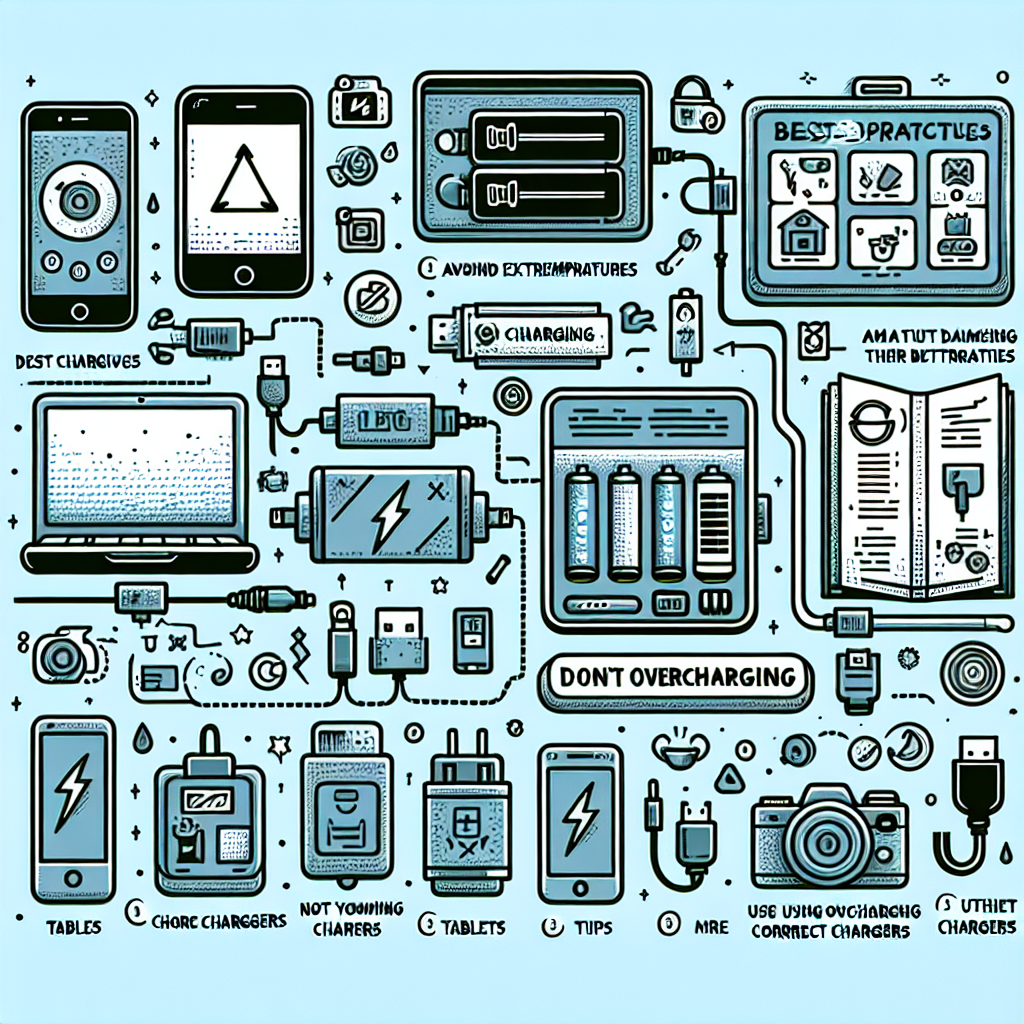No products in the cart.

Best Practices for Charging Devices Without Damaging Batteries
How to Properly Charge Your Phone Battery: Best Practices to Extend Battery Life
In today’s digital age, our phones have become an essential part of our daily lives. From staying connected with loved ones to managing our schedules and accessing important information, we rely heavily on our phones. However, with increased usage comes the need for frequent charging, and this can take a toll on our phone batteries. Improper charging practices can lead to decreased battery life and even damage to the battery itself. In this article, we will discuss the best practices for charging your phone battery to ensure its longevity and avoid any potential damage.
First and foremost, it is important to understand the basics of how phone batteries work. Most modern smartphones use lithium-ion batteries, which are known for their high energy density and long lifespan. These batteries work by moving ions between a positive and negative electrode, creating a flow of electricity. When charging, the ions move from the positive electrode to the negative one, and when using the phone, the ions move in the opposite direction. This constant movement of ions is what powers our devices.
One of the most common mistakes people make when charging their phones is leaving them plugged in overnight. While it may seem convenient, this practice can actually harm your battery in the long run. Lithium-ion batteries are designed to stop charging once they reach full capacity, but leaving them plugged in for extended periods can cause them to overheat, which can damage the battery cells. It is best to unplug your phone once it reaches 100% charge to avoid any potential damage.
Another important factor to consider is the type of charger you use. It is always recommended to use the charger that came with your phone, as it is specifically designed for your device. Using a cheap or generic charger may not provide the correct voltage and current for your battery, which can lead to overcharging or undercharging. This can cause damage to the battery and affect its overall lifespan. If you need to purchase a new charger, make sure to buy one from a reputable brand that is compatible with your phone.
In addition to the charger, the charging cable also plays a crucial role in the charging process. It is important to use a high-quality cable that is in good condition. Frayed or damaged cables can cause fluctuations in the charging process, which can damage the battery. It is also recommended to avoid using your phone while it is charging, as this can put additional strain on the battery and cause it to overheat.
Another common misconception is that you should let your phone battery drain completely before charging it. This is not necessary for lithium-ion batteries, as they do not have a “memory effect” like older battery types. In fact, it is better to charge your phone before it reaches a low battery level. This will help maintain the battery’s health and prevent it from fully draining, which can also damage the battery.
It is also important to keep your phone and its battery at a moderate temperature while charging. Extreme temperatures, whether hot or cold, can affect the battery’s performance and lifespan. Avoid leaving your phone in direct sunlight or in a hot car while it is charging. It is also recommended to remove any phone cases while charging, as they can trap heat and affect the battery’s temperature.
Lastly, it is important to periodically calibrate your phone’s battery. This involves fully charging your phone and then letting it drain completely before charging it again. This helps the battery’s internal circuitry to accurately measure its capacity and can improve its overall performance.
In conclusion, proper charging practices are essential for maintaining the health and longevity of your phone battery. By following these best practices, you can ensure that your battery lasts longer and performs at its best. Remember to use the correct charger and cable, avoid overcharging, and keep your phone at a moderate temperature. With these tips in mind, you can enjoy your phone’s full battery life without worrying about damaging the battery.
Avoiding Battery Damage: Tips for Safely Charging Your Electronic Devices

In today’s digital age, our lives revolve around electronic devices. From smartphones to laptops, we rely on these devices for communication, work, and entertainment. However, with the constant use of these devices, comes the need for frequent charging. While charging our devices may seem like a simple task, it is important to understand the best practices for charging in order to avoid damaging the batteries.
First and foremost, it is crucial to use the right charger for your device. Many people make the mistake of using a charger that is not specifically designed for their device. This can lead to overcharging, which can cause damage to the battery. It is always recommended to use the charger that came with your device or a charger that is recommended by the manufacturer.
Another important tip is to avoid charging your device overnight. Many of us have the habit of leaving our devices charging overnight, but this can be harmful to the battery. Once the battery is fully charged, it is important to unplug the device. Overcharging can cause the battery to overheat, which can lead to a decrease in battery life and even potential safety hazards.
In addition to avoiding overcharging, it is also important to avoid undercharging your device. This means not letting your battery drain completely before charging it again. Lithium-ion batteries, which are commonly used in electronic devices, are designed to be charged frequently. Allowing the battery to drain completely can cause damage and decrease its lifespan. It is recommended to charge your device when it reaches around 20% battery life.
Furthermore, it is important to keep your device and its charging port clean. Dust and debris can accumulate in the charging port, which can prevent proper charging and potentially damage the battery. It is recommended to use a small brush or compressed air to clean the charging port regularly. This will ensure that the charging process is efficient and safe for the battery.
Another best practice for charging devices is to avoid extreme temperatures. High temperatures can cause the battery to overheat and decrease its lifespan. On the other hand, extremely low temperatures can also affect the battery’s performance. It is best to charge your device in a cool, well-ventilated area and avoid leaving it in direct sunlight or in a hot car.
It is also important to note that using your device while it is charging can also cause damage to the battery. This is because the device is using more power than it is receiving, which can lead to overheating. It is best to let your device charge without using it, and if you need to use it, try to limit the usage to basic tasks.
Lastly, it is important to replace your battery when necessary. Over time, all batteries will eventually lose their ability to hold a charge. If you notice that your device’s battery life is significantly decreasing, it may be time to replace the battery. It is recommended to replace the battery with one that is recommended by the manufacturer to ensure compatibility and safety.
In conclusion, charging our electronic devices is a daily task that we often take for granted. However, by following these best practices, we can ensure that our devices are charged safely and efficiently without causing damage to the battery. Remember to use the right charger, avoid overcharging and undercharging, keep your device and charging port clean, avoid extreme temperatures, and replace the battery when necessary. By following these tips, you can prolong the lifespan of your device’s battery and avoid any potential safety hazards.
Maximizing Battery Health: Best Practices for Charging Your Devices Without Causing Damage
In today’s digital age, we rely heavily on our electronic devices to stay connected, entertained, and productive. From smartphones to laptops, these devices have become an integral part of our daily lives. However, with the constant use of these devices comes the need for frequent charging, which can often lead to battery damage if not done correctly. In this article, we will discuss the best practices for charging your devices without causing damage to their batteries.
First and foremost, it is essential to understand the basics of how batteries work. Most electronic devices today use lithium-ion batteries, which are known for their high energy density and long lifespan. These batteries work by storing and releasing energy through a chemical reaction. When a device is charged, the lithium ions move from the positive electrode to the negative electrode, storing energy. When the device is in use, the ions move back to the positive electrode, releasing energy. This process is repeated every time the device is charged and discharged.
One of the most common mistakes people make when charging their devices is leaving them plugged in overnight. While it may seem convenient, this practice can actually damage the battery in the long run. When a device is fully charged, it continues to receive a small amount of charge to maintain its full capacity. This constant trickle charge can cause the battery to overheat, leading to degradation and reduced lifespan. Therefore, it is best to unplug your device once it is fully charged.
Another important factor to consider is the type of charger you use. It is always recommended to use the charger that came with your device, as it is specifically designed for that particular model. Using a different charger, especially one with a higher voltage, can cause damage to the battery. Additionally, it is crucial to avoid using cheap, knock-off chargers, as they may not have the necessary safety features and can potentially harm your device’s battery.
In addition to the charger, the charging cable also plays a significant role in maintaining battery health. It is essential to use a high-quality, original charging cable that is compatible with your device. Using a damaged or frayed cable can cause a short circuit, which can damage the battery and even pose a safety hazard. It is also recommended to avoid using your device while it is charging, as this can put additional strain on the battery and cause it to overheat.
Another best practice for charging your devices is to avoid extreme temperatures. Lithium-ion batteries are sensitive to both high and low temperatures, and exposure to extreme temperatures can cause irreversible damage. It is best to charge your device in a cool, well-ventilated area and avoid leaving it in direct sunlight or near a heat source. Similarly, if you live in a cold climate, it is advisable to let your device warm up to room temperature before charging it.
Lastly, it is essential to keep your device’s software up to date. Manufacturers often release software updates that include battery optimization features. These updates can help improve battery life and prevent damage by regulating the charging process. Therefore, it is crucial to regularly check for and install software updates for your device.
In conclusion, taking care of your device’s battery is crucial for its overall health and longevity. By following these best practices for charging your devices, you can ensure that your battery remains in good condition and lasts for as long as possible. Remember to unplug your device once it is fully charged, use the original charger and cable, avoid extreme temperatures, and keep your software up to date. By implementing these simple practices, you can maximize your battery’s lifespan and enjoy your devices for years to come.

Add comment
You must be logged in to post a comment.